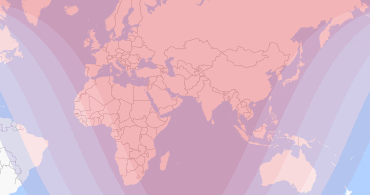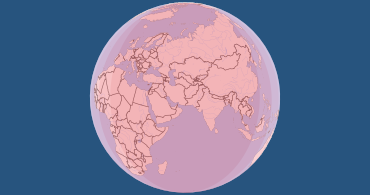This eclipse is visible in Columbus - go to local timings and animation
Where to See the Eclipse
Try our new interactive eclipse maps. Zoom in and search for accurate eclipse times and visualizations for any location.
Regions seeing, at least, some parts of the eclipse: Europe, Asia, Australia, Africa, North America, Much of South America, Pacific, Atlantic, Indian Ocean, Arctic.
This eclipse is visible in Columbus - go to local timings and animation
Eclipse Map and Animation
The entire eclipse is visible from start to end.
The entire partial and total phases are visible. Misses part of penumbral phase.
The entire total phase is visible. Misses part of partial & penumbral phases.
Some of the total phase is visible. Misses part of total, partial & penumbral phases.
Some of the partial phase is visible. Misses total phase and part of partial & penumbral phases.
Some of the penumbral phase is visible. Misses total & partial phases.
The eclipse is not visible at all.
Note: Areas with lighter shadings left (West) of the center will experience the eclipse after moonrise/sunset. Areas with lighter shadings right (East) of the center will experience the eclipse until moonset/sunrise. Actual eclipse visibility depends on weather conditions and line of sight to the Moon.
When the Eclipse Happens Worldwide — Timeline
Lunar eclipses can be visible from everywhere on the night side of the Earth, if the sky is clear. From some places the entire eclipse will be visible, while in other areas the Moon will rise or set during the eclipse.
| Eclipse Stages Worldwide | UTC Time | Local Time in Columbus* | Visible in Columbus |
|---|---|---|---|
| Penumbral Eclipse begins | Dec 21 at 16:59:25 | Dec 21 at 11:59:25 am | No, below the horizon |
| Partial Eclipse begins | Dec 21 at 18:04:47 | Dec 21 at 1:04:47 pm | No, below the horizon |
| Full Eclipse begins | Dec 21 at 19:09:13 | Dec 21 at 2:09:13 pm | No, below the horizon |
| Maximum Eclipse | Dec 21 at 19:55:03 | Dec 21 at 2:55:03 pm | No, below the horizon |
| Full Eclipse ends | Dec 21 at 20:40:48 | Dec 21 at 3:40:48 pm | No, below the horizon |
| Partial Eclipse ends | Dec 21 at 21:45:13 | Dec 21 at 4:45:13 pm | No, below the horizon |
| Penumbral Eclipse ends | Dec 21 at 22:50:43 | Dec 21 at 5:50:43 pm | Yes |
* The Moon is below the horizon in Columbus some of the time, so that part of the eclipse is not visible.
Quick Facts About This Eclipse
| Data | Value | Comments |
|---|---|---|
| Magnitude | 1.462 | Fraction of the Moon’s diameter covered by Earth’s umbra |
| Obscuration | 100.0% | Percentage of the Moon's area covered by Earth's umbra |
| Penumbral magnitude | 2.514 | Fraction of the Moon's diameter covered by Earth's penumbra |
| Overall duration | 5 hours, 51 minutes | Period between the beginning and end of all eclipse phases |
| Duration of totality | 1 hour, 32 minutes | Period between the beginning and end of the total phase |
| Duration of partial phases | 2 hours, 9 minutes | Combined period of both partial phases |
| Duration of penumbral phases | 2 hours, 11 minutes | Combined period of both penumbral phases |
Eclipse calculations usually accurate to a few seconds

An Eclipse Never Comes Alone!
A solar eclipse always occurs about two weeks before or after a lunar eclipse.
Usually, there are two eclipses in a row, but other times, there are three during the same eclipse season.
This is the second eclipse this season.
First eclipse this season: December 7, 2094 — Partial Solar Eclipse

